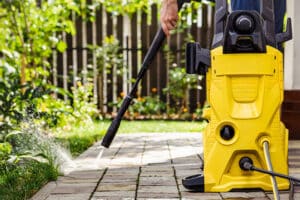Building Patio Pressure Washing San Antonio, Texas
Different Types of Patios and How to Clean Them
Patios can be made from various materials. As such, it’s essential to tailor the cleaning method according to the material used to avoid damaging them.
Concrete
To clean a concrete patio, it is recommended to use a 25-degree nozzle and a pressure level of 2,500 to 3,000 PSI. Apply the detergent and rinse using sweeping motions, repeating the process if necessary. For better protection and a longer lifespan, finish off with a sealer.
Wood
Instead of detergents, use a wood cleaner to safely clean wood without discoloring or damaging the material. Take a brush to scrub the cleaner onto tight corners and spaces. Use a pressure level of 500 to 600 PSI, a 25- or 40-degree nozzle, and a rotating brush attachment to avoid etching the surface, making sure to follow the grains when washing.
Brick
To wash brick patios, make sure to first wet the surface with water to avoid letting the detergent soak in. Brick is very porous and can easily absorb liquids. Soft washing is best for brick, especially old brick, so it is best to use a low pressure level to rinse it down.
Stone
Ordinary laundry detergent can be used to clean stone patios, but stubborn dirt, algae, and stains may require the help of bleach. Use only thin, plain bleach without any added chemicals or detergents. Wash down the bleach or detergent using low pressure.
Tile
Make sure to inspect tile patios first before cleaning. Avoid power or pressure washing if there are any gaps or openings as water can settle inside and cause damage. Start with a pressure level of 500 PSI, as too high a pressure can destroy grout and caulked seams. Increase the pressure level if necessary. For ceramic and porcelain tiles, don’t use a power washer.
